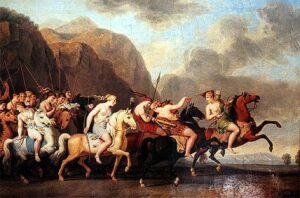My inspiration from this article comes from the comments left on my “Bisley Boy” post, particularly the one left by historian and author Leanda de Lisle who said:
“I’m afraid this kind of sexist myth about Elizabeth is not that uncommon. In the sixteenth century it was believed that women who exercised power over men lost their femininity and were rendered barren. It was an idea drawn from the Greek myth of the masculine women called the Virago, And these beliefs are surprisingly persistent, In 1985 a doctor Bakan went so far as to suggest that Elizabeth’s mental toughness suggested she suffered from testicular feminization and was genetically male. I discuss these theories briefly in my book on the Grey sisters (Jane, Katherine and Mary).”
I just had to research this further and look into the work of Dr Bakan!

A Virago
I must admit to knowing the word “virago” but not really knowing what it meant or the story behind it. Here are some dictionary definitions I found:-
virago
Etymology: Middle English from Latin viragin-, virago, from vir man
- A loud overbearing woman
- A woman of great stature, strength and courage
- A noisy or scolding or domineering woman
- Amazon – a large strong and aggressive woman
- A strong, brave or warlike woman
- A strong, large, man-line woman; an amazon
The term “virago” seems to be interchangeable with “amazon” which refers to the Amazons, a race of women warriors in Greek mythology who inhabited Scythia, near the Black Sea. Their society was matriarchal and one myth states that no man was allowed to live in their lands but that they visited a neighbouring tribe once a year to have sexual relations in order to prevent their race from dying out. If male babies resulted from these encounters, they would be killed, left in the wilderness or sent back to their fathers. It is said that they cut off or burned off one breast so that it was easier for them to throw spears.
It is easy to see why Elizabeth may be called a “virago” or “Amazon”, after all, she was tall, aggressive, brave, domineering and scolding, but these terms are not always complimentary terms in that the Amazons were seen as man-haters. Far from being a man-hater, Elizabeth seemed to come alive in the presence of men and enjoyed flirting with them and sharing her wit and intelligence.
Genetically Male

I looked up the work of R. Bakan, from the Faculty of Education, Simon Fraser University, Burnaby, B.C., Canada. Bakan wrote an article, or medical hypothesis, entitled “Queen Elizabeth I: A Case of Testicular Feminization” in 1985. In this article, Bakan puts forward the idea that Elizabeth I was a case of testicular feminization and that this diagnosis explains why she never married, why it was believed that she had some kind of congenital defect or was barren, and that is also explains her physical appearance, behaviour and character. Bakan says that although many modern historians believe that Elizabeth’s refusal to marry has a psychological explanation, s/he believes that:
“recent advances in our understanding of the process of sexual differentiation, particularly, the description of the testicular feminization syndrome, justify a re-evaluation of the “physical defect evidence” of Elizabeth’s contemporaries.”
Before we go into Bakan’s reasoning as to why s/he believes Elizabeth may have suffered from this syndrome, let’s find out a bit more about it.
What is Testicular Feminization Syndrome?
Bakan explains that the term was first used in 1953 and that it describes an hereditary disorder of sexual differentiation which is probably transmitted by the mother. Bakan goes on to explain that sufferers are phenotypic females, although they have internal testes and X and Y chromosomes, and that the syndrome is rarely accompanied by any other abnormalities. The sufferer’s external genitalia are female, but the uterus and uterine tubes are either rudimentary or absent, and the vagina “ends blindly in a pouch or is absent”. The sufferer is always sterile, although menstruation can occur in a few cases.
When the sufferer hits puberty, breast develop normally and she appears female. Characteristics include slim hips, large hands and feet, thin and elongated hands and fingers, and sufferers tend to be tall and attractive. Their sexual orientation is always female and they enjoy the company of buys, sport and “rough” games in childhood. They also tend to be of above average intelligence and very practical.
Bakan sums up the characteristics of someone with testicular feminization by saying that:
“testicular feminization individuals typically present attractive, intelligent, practical females, above average in height, slim, active, athletic with notably long and beautiful hands. They have a normal life span and are free of related
illnesses and obvious malformations. The only signs of abnormality are the lack of menstruation and the absence or
foreshortening of the vagina.”
Sound familiar?
Testicular Feminization and Elizabeth I
Bakan says that “the characteristics of persons with this syndrome are strikingly similar to descriptions, by her
contemporaries, and by historians, of Elizabeth’s appearance, personality, and behaviour, as well as of the specific physical defects which they believed made her sterile and unwilling to marry.”
We know from the portrait of the young Elizabeth, which accompanies this post, that Elizabeth had lovely long slender hands with long and elegant fingers, but Bakan also uses the words of P Johnson, who studied portraits of the Queen along with contemporary descriptions and concluded:
“she was a little above average height for her time and class; that she was slim and extremely active;… On one point all authorities written and visual are agreed: she had beautiful hands, with long fine fingers, to which
she loved to draw attention by repeatedly drawing off, and putting on, her gloves. There can be little doubt that, in her day, she was an attractive woman”
A M. de Maisse is also quoted as saying:
“…she drew off her glove and showed me her hand, which is more than mine by more than three broad fingers. It was formerly very beautiful, but it is now very thin, although the skin is still most fair.”
after visiting the Queen in 1597.
Bakan also points out that her gloves, which are now in the Ashmolean Museum, are evidence of her abnormally long fingers and the fact that her fourth fingers were longer than her index fingers, a common male trait.
As far as her personality is concerned, Bakan talks of how the Queen showed many “male” characteristics in that she was physically aggressive and swore a lot. He quotes her tutor, Roger Ascham, as saying that she was “intellectually masculine” and William Cecil as saying “that if today she was more than a man, tomorrow she would be less than woman”. Bakan also points out her attitude towards marriage. There are many examples of Elizabeth speaking out against marriage and insisting that she would remain a virgin and never marry, and Ascham likened her to Hippolyta, Queen of the Amazons, “for by nature, and not by the counsels of others, she is thus adverse and abstinent from marriage.”
But is there any evidence of Elizabeth I having any reproductive abnormalities to back up Bakan’s claims?
Bakan thinks so. Bakan cites historians J Morris and Alison Plowden as saying that she had either amenorrhea (the absence of menstruation) or irregular periods. Ben Jonson is also quoted as saying:-
“she had a membrane upon her, which made her incapable of any man, though for her delight she tried many. At the coming over of the Duke of Alencon there was a French surgeon who took it in hand to cut it, yet fear stayed her and his death”
and French writer, Brantome, as saying of a woman, thought to be Elizabeth:-
“she was unfit to be a wife having only the smaller opening through which she passed water.”
Mary Stuart (Mary Queen of Scots) also remarked in a letter that she had heard from Lady Shrewsbury that Elizabeth was foolish for desiring a marriage with the Duke of Alencon when such a union could not be consummated, and it seems that Quadra and de Feria, the Spanish ambassadors believed that Elizabeth could not bear children.
According to Bakan, the historians Pollard and Mumby concluded that, on the basis of evidence from her contemporaries, that Elizabeth had some kind of physical defect that made childbearing impossible and Pollard points out that Elizabeth, as monarch, would never have willingly refused the chance of producing an heir to carry on the Tudor line and to secure the throne, so she must have had no choice in the matter.
The Psychological versus the Physical Explanation
Many of today’s historians argue that Elizabeth’s refusal to marry and her desire to remain a virgin are to do with psychological reasons, rather than physical ones. Psychological reasons could include:-
- Elizabeth linking sex with death – Alison Weir writes of how Elizabeth could have linked the two because of her mother and stepmother both being executed for adultery, Catherine Parr dying in childbirth and her Thomas Seymour, the man she first had any type of sexual experience with, being executed also.
- A fear of childbirth – Her stepmothers, Catherine Parr and Jane Seymour, had both died after childbirth, as had her grandmother, Elizabeth of York.
Bakan discounts these reasons, arguing that we cannot use today’s psychoanalysis and views on marriage to explain the behaviour of a 16th century queen, and that Elizabeth’s characteristics along with her instructions in her will, that her body should not be examined or embalmed, point to her having a physical defect which she believed made her barren and that is why she refused to marry.
My Thoughts
Bakan’s theory is an interesting one but it seems to be flawed in that, according to his/her own words, testicular feminization is hereditary. Anne Boleyn had a few pregnancies and obviously gave birth to Elizabeth, so she must have had a normal, functioning womb, and Elizabeth Howard, Anne’s mother, was said to have given her husband, Thomas Boleyn, a baby every year although only 3 survived childhood. Bakan also talks of how Anne Boleyn had six fingers and that this type of abnormality can be related to developmental disorders. But, I don’t believe that Anne had six fingers anyway. I can’t see Henry VIII moving heaven and earth to marry a six fingered woman who could pass on such a defect to the heir to the throne, can you?
Why, oh why, do we have to think that there was something wrong with Elizabeth for her to choose celibacy? OK, it was seen to be her duty to provide and heir but she was monarch and she was in charge, if she refused to marry and have children then what could anyone really do about it? Why do people need to explain her choice by making out that she was psychologically damaged or had some kind of defect or abnormality?
Also, I find it annoying that Elizabeth is seen to be masculine just because she was strong and courageous. I know that there were very strong views about women and how a woman should behave in the 16th century, but haven’t we moved on from that. Can’t a woman govern a country successfully without being likened to a man? I’m no feminist but I think we are taking so much away from Elizabeth and her incredible achievements if we say that she had male characteristics.
My own opinion is that Elizabeth was a strong woman who was well ahead of her time and her world, and even ours today, could not cope with that.
Well, I’ve rambled on for far too long, what do you think? Please share your opinions below.
Sources
- “Queen Elizabeth I: A Case of Testicular Feminization” by R. Bakan – This can be purchased from http://www.sciencedirect.com/ for $31.50, just search for the title or author.
- “Elizabeth the Queen” by Alison Weir
- “The Sisters Who Would be Queen” by Leanda de Lisle











